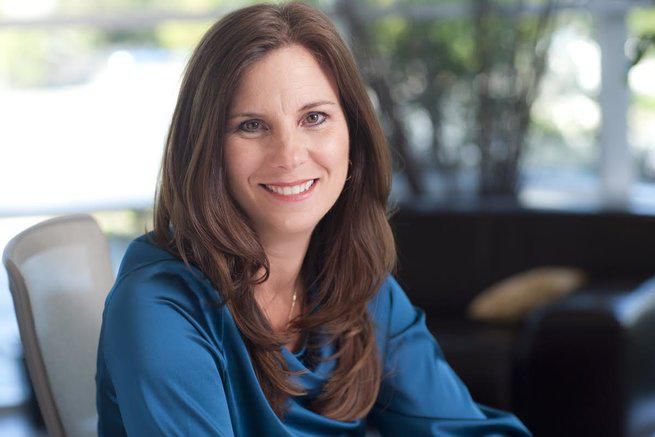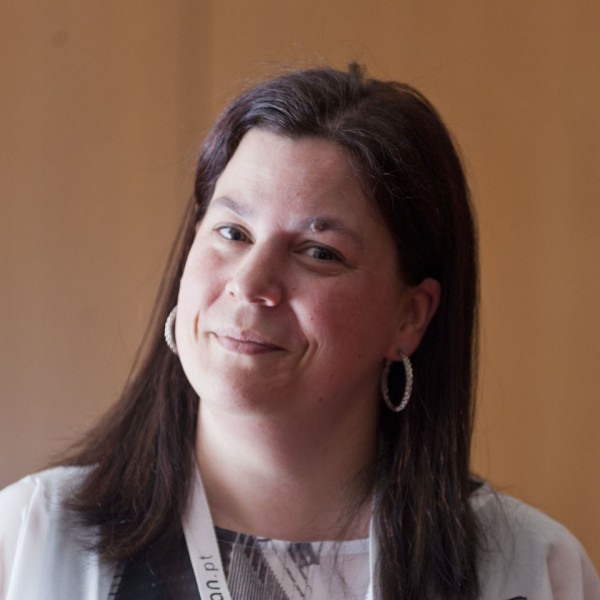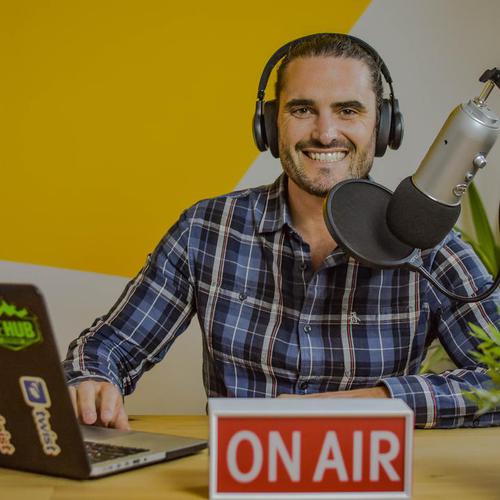Communicating ideas in business has always been a challenge. In the early 2000s, there was really only one option: PowerPoint.
Nancy Duarte was a voice in the darkness to show that if you were going to use slides to communicate your message, you needed to think visually and level up your design thinking.
Twenty years and one pandemic later, we have a lot of ways to communicate a message. In addition to slides, you can do video messages, channel posts, instant messages, email, webinars, and many more.
When you have so many options, it’s important for leaders to know how to pick the right way and how to craft their message.
It’s not just the slides anymore
When communicating an idea remotely, presenters now have to think about not only their visual message, but how they personally look, and also what’s in their background. Those are three unique challenges that we didn’t have to worry about before.
Each person watching your presentation will also have a unique experience. Their screen may be similar, but you can’t control everything else that is on their screen or surrounding it. Nancy said, “Your competitor is their inbox.”
In fact, most communication of ideas isn’t about a presentation at all. It’s about how to deliver ideas, and then have a conversation about them. The conversation is more rich and makes a bigger impact.
People are craving presence
Video meetings aren’t the same as being live in the same room as others. Nancy said that presenters need to be even more “human” than usual, exaggerating gestures and making others feel like they are interacting with someone real instead of just another box on a screen.
Adding as much humanity as possible is essential to communicating a great message.
Match the medium to the message
The biggest challenge for leaders today is not the message itself, but picking the right medium to communicate it. The choice of the medium is dependent on:
- the message itself (or “is” the message according to Marshall McLuhan)
- a read of the room of what people need
- the context of when the message is coming out
Masters of communication in the digital age will understand this and make the shifts when they need to.
Nancy says, “I really think the ones who understand how to collaborate and communicate remotely through technology, through sincerity, and within a culture, are the ones that are going to win.”
Links
Welcome to The Digital Workplace podcast. Today is a very special day. We have a fantastic guest with us. We have Nancy Duarte. She’s the principal of Duarte Design. How are you, Nancy Duarte?
I’m good. Thanks for having me.
Oh, this is my pleasure. I was telling you before the show started, you have been a very central figure even in my journey, when back in 2012, I was just doing some corporate training and using the same old slides. And I knew they were bad, but I didn’t know how to fix them. So, I read your book ‘Slide:ology’, and it just opened my eyes to everything. And it was then. And I actually, right now, I have the book with me. I’ve kept it all these years. So, I was wondering if you would do like a digital sign, just kind of act like you’re going to sign. There you go.
I’ll sign it there.
There you go.
Send me your address. I’ll ship you an actual book.
Fantastic. It’s so good. Nancy Duarte, you are one of those leading voices, but your voice, it’s able to make things so enjoyable and so real. So, just the whole idea of design coming into the digital world, in terms of presentations was foundational, back in that time. Now, here we are almost 10 years later and we’re still struggling with a lot of the same things. So, we’re going to get into that discussion. But first, I want to ask you a question, like a capture question to prove your humanity, as we enter into this digital podcast. I’m still a little nervous right now, just to tell you the truth, just because I admire you so much. So, I want to know who you get weak kneed and nervous around if someone comes to you and asked to do a presentation. Give me a name that would be like, ‘Oh, gosh,’ and you’d get all nervous about.
That I don’t know. Yeah, I don’t work on the presentations. Fortunately, I hired people smarter than myself. So, I don’t work on presentations anymore. The situation I actually get the most nervous in is when I have to present to my own team. Can you imagine what it’s like to have to stand up and present in front of presentation experts. Like afterwards, the coaches are like, ‘you said umm’ and ‘you did this’, and ‘your slides weren’t effective’ or whatever. So, I get really nervous. I have to calm myself down and breathe when I’m presenting to my own company. But we’ve had the privilege of working with some really spectacular people. So, I think I know they’re all human. So, none of those intimidate me anymore.
Yeah. And that’s a wonderful thing to realize that behind all the hype around people out there, they really are just humans that we’re all working with.
We’re all flawed. Life’s hard for all of us. So.
It’s true. It’s true. Well, great. Let’s get into this, Nancy Duarte. We’re talking about communicating your business ideas in a digital world. I’m going to start off. You had an article about some new virtual events. Obviously, this last year has been something none of us really expected. But with so much of our going digital, you have a message that you put out there in terms of stick to your story, find out who you’re trying to connect with, enter into their story. Do you feel like, as people are shifting into this almost completely digital world, do you stick with the same script and say, ‘Hey, the same principles that we had before we’re going to stick with?’ Or do you feel like you’ve had a shift and had to alter some of the messaging that you do?
Yeah, the whole world is going to be different. And I think the people that keep saying, ‘Oh, I can’t wait for things to get back to normal’, are going to be surprised that there isn’t normal, like there is no ‘back to normal’ now. I was just listening on Clubhouse to some sessions that Andreessen Horowitz was sharing. And they surveyed 200 of their companies that are the most, what they would call ‘normal’, typical C Corp, Delaware Corps and 98% of them plan to stay remote. So, there’s going to be a really different way that we approach work. And the thing that’s the most fascinating to me is, I really think the ones who understand how to collaborate and communicate remotely through technology, through sincerity, and within a culture, are the ones that are going to win. I think there’s going to be like a leapfrog of the ones who are more effective with remote communication than the ones who are not. So, it’s a real thing and it’s here to stay.
Yeah, absolutely. Let’s talk to that person who has presentations as still part of their life. Presentations are still a part of business. We haven’t got rid of those. Earlier, a lot of your writing and your influence impacted people who were using digital tools to deliver a presentation, but still maybe in the same room as other people that were there. Now, we’re in a situation where I could be giving a presentation from my bedroom, to, again investors or to clients, whoever’s out there. What do you see are some of the struggles as we tried to adapt to that kind of world?
Yeah, it’s going to be a long time I think before people are ready to get into the room. So, we had to flip some of the largest events in the world from in person to virtual, and we’ve learned a lot along the way. Some is more user generated content where you work from home, others have the big-branded background or like they’re sent to a video studio with the full green screen where it looks like they’re actually immersed in an environment, like the production quality goes every which way that you want. But every single day, I literally will turn on my camera, make sure there’s no trash behind me. I didn’t even hire a guy one time. He was super great to interview with, like wore a little suit and tie to my interview. But he had a KitchenAid and filthy dishes on the kitchen island behind him. And I was like, I can’t handle it. I’m visually overwhelmed. We said show up and pretend you’re selling to a CEO, and I was like that, that. Like I’m sorry, but the amount of clutter and chaos.
So just like Slide:ology had visual norms, we have three visual norms we have to care about. We have to care about what’s behind us; we have to care about how we show up, how we look, our presence and we have to care about the graphics that are going to be in front of us or to the side of us. So, there’s now multiple layers. We just had to worry about our slides and then walk on stage. And now, it’s more complicated. How we construct our content slides and how we deliver it is also changing. It’s a completely different recipe. So, we are coming out with a book in the fall around how to create a connection when you’re presenting virtually. And that’s the most important thing, like that is the most important thing through your content, your visuals and how you deliver it. So yeah, the rules have changed quite a bit.
Let’s get into that a little bit, Nancy Duarte. In terms of creating a connection over a virtual platform like that, what are some of the unique things that people need to think about and do and plan for to make that happen?
Yeah. So, we have a Duarte method, that’s, you have to have your strategy or your plan. Then you have story, visuals, and delivery. So, the content has to be bite sized pieces. The human brain likes novelties. So, the minute you introduce something novel, people will be like, ‘What just happened?’ So, you can do that through bite sized pieces of content. Sometimes I’ll squeal, and I’ll be like, ‘Oh, my God, look at this slide.’ Right? Your competitor is their inbox. So, you want to keep driving them back to what you’re saying. Having another voice, having somebody else there, makes it more conversation. Your brain re-engages. Every time you speak and then I speak, they’re like what’s going on. So, you have to chunk out your content a bit differently.
On the slide category, you don’t have to project everything. You don’t have to project your notes. You really only need to share your screen in the very moment that you have something visual that they really need to look at. Otherwise, you’re better off using your own human form and eye contact. So, like right now, I see your face but you’re lower in my screen and I’ve not looked at your face once. I’m looking at the little dot at the top of my screen. I’ve never even looked at you for real and that creates strain, because I want to have eye contact with the people that are listening. And so, it’s harder. Like I’m more fatigued in a situation like this than I would be if you and I were just sitting in a room chatting and a video camera was over here somewhere. It’s just more fatiguing, and it takes more physical, emotional, and focused energy to come through the camera.
I was watching a friend of mine at a conference and she was so spectacular. Like her arm movements were great. Her vocal variety was up and down. And she was leaning in. And I just sent her a note. I was like, ‘I felt like I was finally in the room with someone.’ I would normally say, ‘Don’t be so big and loud.’ But I was just like, ‘Oh my god. Finally, I felt like I was in a room with another human.’ And I think that’s what’s going to be really sorely missed. Now, granted, eventually, we’ll all be able to go out at night and be able to go to a ballgame. We’re so trapped in our homes. But right now, I just loved her because I was like, ‘Oh, my God. I felt your presence.’ And I think that’s what people are craving. That’s what we want.
Definitely.
Yeah. And even when we’re back, we will still want that.
Yeah, that’s kind of a big issue too of what happens when we get back in those situations. I want to know, like, I’ve sensed the need because even when you’re talking about planning a meeting, if you’re the initiator of the meeting, or a presentation, you have to start planning that visual experience in a much broader way than you did before. Like if you were all in person, you could just count on being in a room or if you’re giving a presentation on stage, you didn’t have to worry about where the seats were aligned or what else was in their viewpoint. But now you have to think about, ‘Okay, when do I need to share my screen? How long have people just been staring at the same thing that hasn’t moved for a long time?’ And thinking about those things is an additional thing that most people aren’t used to doing. Right?
Right. Right. Yeah, you have to bring your own setup. It’s like when you’re in a big-stage event, you have an AV person, you have the producer calling the plays, you got someone else changing up the slides and your clicker works every time. So, here you’re your own AV, you’re your own IT support. I’ve learned more about technology in this season. You know, can I click the right arrow? Do I have to click the down arrow? All the tools are different, right? And you have to have trials. I tried to do a dry run and reorient myself. Because I’ve presented through every single tool. I have to show up and be in the tool that the audience is using. And so, each of them is really really different. So yeah, you have to be ready for anything. Like for this. You saw.
Yeah. That was a good point.
I tested at home. With my internet, something is wonky. I brought not one, I brought two computers. Both are hard wired and wireless. I logged in on the one on the other side of the room. Didn’t work. So, I dashed right over here and this one did. Like it’s that kind of stuff. I used to travel with two laptops. I know Guy Kawasaki travels with his own headset. Different people have their own little pet things. And that’s kind of what’s happening now too. We’ll all have our own kind of pet technology that we think works the best.
Yeah. Because like you said, we’re on a platform you haven’t been on before. And you never know when that’s going to happen. Like you might know Zoom. Okay, we all can have that in mind. But there may be something different somebody throws at you.
Yeah. I’ve been thrown everything.
I want to get into a term, Nancy Duarte. I love Slide:ology, but when you came out later with this term of, I think you called it a “slideument”. Is that correct?
A slide doc. Yes.
Slide doc.
Slideument is Garr Reynolds.
Okay okay.
And my fun secret is, the cover of Slide:ology is a silhouette of Garr Reynolds.
Oh no way.
I admire him that much. I enshrined him on the cover of Slide:ology.
That’s funny.
He’s the one. I would never have written that book if he hadn’t asked me to and begged me to and held me accountable to. So yeah, slideument is his terminus. He considers it negative. Like don’t make slideument. Whereas I was like, about 85% of the things done in presentation software are in service of a denser visual document that travels around without the help of a presenter. So, I call them a slide doc. And slidedoc.com and slidedocs.com, there’s a free book out there. But like, yeah, just use it, exploit it. Put full sentences on there and let it circulate without a presenter. And it really is effective.
I love the honesty that you approach that with, in just saying like, ‘Look, this is happening. It’s going to happen. So, let’s see how we can bring more signals, bring more fidelity to the conversation that you’re having and add more visuals to that and just start to think.’ And I think even that is a good step towards where we are now in digital collaboration, in saying it’s not just text. You have to bring in lots of other things to show what’s going on.
Exactly. And sometimes, there’s even a placemat, whether it’s digital or in person, where you throw a graphic up there, a model or a concept, and people pile in and are like, ‘I don’t agree or I agree.’ It’s just a framing device sometimes for conversations. So, doing it well pushes ideas forward and creates traction.
What are some of the things that you are excited about for moving into this more visual age where we can kind of present everything from our home or from remote locations? Now I think pretty much every event from here on out is going to have some kind of remote element to it as well, even if people are in the place. What gets you excited about that world?
Yeah. I actually like this blended world. I have loved not having to travel to do keynotes. So, to be honest, I just told a client yesterday, ‘Yeah, I don’t travel anymore’. That’s cool. And I think what’s going to happen is as we go into these blended environments, I think if this season hadn’t happened, anyone who is in the remote audience would have felt like a voyeurist or not part of the audience. So, those days are over. People will be immersive in the remote experience and the larger events are going to be really beautiful and really well done. I think there’s technology coming out that’s really fun, that’s trying to help with collaboration, with presenting, with this ability to create pretty good videos of yourself that can circulate and be your proxy, if you can’t be there in person. There’s all kinds of things happening with, you know, the “Beam me up, Scotty”, where I could stand at home but look like I’m on stage and all that kind of stuff. So, there’s a lot of room for innovation people weren’t expecting, which is going to be fun to see what happens and who wins.
Definitely. Nancy Duarte, one of the things that I feel like the digital age has brought on is just so many new options that we have. So, before, it seemed like, okay, if you’re going to give a presentation, get your slides ready. That’s it. Now we have a world where, okay, if I’m going to present an idea, okay, I could use slides, or I could do a slide doc or something like that. I could do more of a collaborative Google Doc, if it’s just me and some other people that I just need to run an idea by. I could do a recorded video of myself. Like there’s so many new options that are there. What are some frameworks that people can use to start to think through those options?
Yeah. I love that you’ve put the ability to collaborate around a doc because I know some cultures don’t even have internal presentations anymore. Everyone piles into a document. Once everyone’s signed it off, it’s like, done. It’s approved and you have consensus going forward. I think I changed a lot in this season. So, I delivered 22 video memos, and I did it because I really felt like people had to see me. That’s my other machine that I just told you about. It’s calling me.
There you go.
Yeah, so I did 22 video memos. And the purpose of them was for people to see me in my home, to see me real, to see my struggle for them to know and understand me in a more clear way as I rolled out the different steps we were at, and the next step and what it was going to be. I made it really clear. And I got a lot of notes. I think in some ways it was my finest hour, because it was really, really good. And people still go up and watch some of them, like they’ve favorited them or something. They go up and continue to watch them and get views. And I think that was the right thing. No slides ever.
The other thing that’s happened in this season was we did a lot of storytelling. And one of my executives had told a story about how her son, the previous year, had taught her to be brave. And he has Down’s syndrome. And so, she taught us the sign language for ‘brave’. And it’s you put your hands like this and you come out like that. But that also means courage. It means ‘heal’. It means a whole lot of stuff. And so, that sign has become something that became very important, even in the memos. If I had slides up, you would see it every time I said brave. Now, it’s just become this natural gesture that I do. And it’s become so deeply seated in who we are.
And so, I just think it was a season where I needed a lot of eye contact and love, as much love as I could get to come through. I wanted them to feel supported and loved. When the wildfires hit, I was like, ‘Look, just get out. If you can’t afford to get out, you just get out. And here’s my number and call me and I will pay for whatever you like.’ And people could sense my urgency and they could sense my sorrow. And I tried to feel what they were feeling every step of the way.
And because you were able to do that on a video note and it was recorded, they could see it, they didn’t have to see it live. They could see it later.
Exactly. They could watch it whenever.
Yeah. That’s an amazing thing. So, Nancy Duarte, is there a way that you would help leaders now as they’re thinking about delivering messages to know, I mean, is it just kind of a gut feel when you need to shift towards one medium versus another or are there good situations and guidelines you can give?
Yeah. I think it depends on your strategic plan, right? There’s many, many moments of communication from email to collaborating in a document. There are these moments that rise above the rest, where you need that communal effervescence, and first stopping and recognizing that this is a moment that needs extra communal effervescence. You got to stop then. Sometimes we just pile, pile, pile, broadcast, broadcast and stuff. And so, I think that the ability to stratify the moments and really understand, ‘Oh, this can be just a quick call, this could be a quick email, this right now we need to gather, we need some ceremony and so on.’
So, I did write a book called ‘Illuminate’ co-authored with Patti Sanchez, who’s amazing and it is about endings and beginnings. We wrote it in 2016. That was about the cycle of when a crisis should happen. Four years later, now we’re in the middle of one. No one would have guessed anything like this. But that’s what it’s about. It’s about the different steps of a transformation and how the leader is going to feel at a different place than the people. How you need to listen to them and show up the way they receive information, for different situations require different things.
If you have a pitch, you always send a slide doc as a read ahead. And then in the moment, you have a short story, and then you have appendix, your question-answer, and then you do a slide doc as a leave behind. You know, this is just typical. Similar with sales. So, different tools for different moments. And right now, you can show a pretty novel on screen. We’ve had puppets appear, we’ve had the mascots of our clients show up in the scenes, and then all of a sudden when someone said a certain word, all of us changed our backgrounds at the same time, just to create customer delight and even internal delight. We just had an internal meeting where there was gamification. It was just hysterical. It was really fun. So, it just depends. I felt like everyone needed to laugh and they just did, and it was fun. Like it’s situational. I guess you could call it situational planning. But you’re right.
There are so many things to bring in. It’s about your strategy, like you said. What do you want to do, what’s your goal out of this, but also reading the room and reading the community that you’re around. What do they need right now? That changes everything. There’s just so many options.
And it’s gotten more complex. You started with that, like, Wow. Now, we have gobs and gobs of choices, you know, and technology choices. Yeah, it’s gotten more complicated for sure.
Definitely. I mean that’s the world we live in now. We have so many more options there. And we love having options, but sometimes it’s nice to have a little bit fewer.
I’d stop the options.
Definitely. So now, Nancy Duarte, as you’re thinking about, we’re moving into this new world of how we get going. When somebody is trying to run a meeting, let’s just take the idea of distractions that are there. What are some good ways that you would recommend to help to combat distractions? Particularly like you said earlier that now, your main person that you’re combating against is their inbox or clicking on a new window or opening up something. So, do you have any good tips about how you can help people to deal with preventing other people to get distracted during their presentations?
Yeah, I think it’s interesting because some of it is driven by the culture. If it’s just a random event that gobs of people are attending, most of the time you don’t even know who’s there. They don’t turn on your camera. We have an on-camera culture. I didn’t demand it. It’s just like everyone pops in. We’re so happy to see each other. So, we have a ‘camera on’ culture, I would say. I popped into other meetings, camera on, all excited, and everybody’s hidden. So, I think that a ‘camera on’ culture eliminates distractions, because people can see, ‘Oh, you know, you’re muted, but you’re on your phone. You’re muted, and just your eyes are all over the place.’ You can tell when someone’s distracted. So, we just have a ‘camera on’ culture. So, when we’re there, we’re engaged. But the big lure is the inbox. That is the big, big, big blinking light, because they’re making a choice. Do I want to spend an hour with you? Or do I want to go and cook dinner an hour earlier than I would if I didn’t engage with you right now? It’s a bet with their time.
And so, there are times where it’s like, okay, cameras off and it’s more like a radio show and you’re just listening. And I don’t see a problem with that. I do a panel with other CEOs. And I told my team, ‘Hey, come. Have the camera off. Pretend its radio. It’s just for fun and it’s for your benefit. You don’t have to be on.’ And I have a lot of good feedback from that. So yeah, it depends, right? It’s situational. Again, it all comes back to what you’re trying to accomplish. Audiences at a big event, probably 80% of the audience will either want to watch it when it’s convenient for them to be engaged more, or they won’t be fully engaged.
Yeah. And you talked about Clubhouse earlier. I feel like there’s something almost magical about the fact of like, it’s not recorded. You can’t go back and listen to it later. You have to be ‘live’ for those things. And some of that really pulls people in. And we got used to all these webinars and everything’s like, ‘Hey, you can watch it whenever you want.’ Well, I’m never going to watch it. Because I don’t want to have just an hour sitting around to watch these things. And it’s really powerful.
Yeah. Yeah.
Very good. Well, Nancy, as we close this discussion, I want you to tell us, you’ve seen a peek into the future, what’s going to happen. You talk about this new book you have coming out. What are going to be the things that, 20 years from now, no matter what technology throws at us, no matter what new pandemics we deal with, what’s the same message you’re going to keep saying regardless of what we interact with?
Yeah, so for clarity, Patti Sanchez on my team is writing that book, and it’s beautiful. I’ve just seen the outline and it’s going to be amazing. So, I think the thing that’s going to be true in the Duarte method I mentioned, it’s got story, it’s got visuals, it’s got delivery, but where that Venn diagram overlaps, is empathy. So, even though we’re adding things like listening and different kinds of communication methods to showing up with strong soft skills, empathy will always be where everything dovetails in our world. Empathy first, always. And I, personally, story will always be story framework, story methods, story is applied to business. That will always be something that is in my heart forever. So, empathy as far as the company, and then for me, story is pivotal for me.
Yeah. Once you interact with the Joseph Campbell method, you can’t unsee it, right?
Exactly. You can’t unsee it.
Yeah. Well, Nancy Duarte, this has been great. I loved this conversation. There’s so much to unpack around what it means to tell the story visually and tell the story in a digital way, in this new world. So, Nancy, thanks so much for being on the show. If you could send anyone anywhere in the digital world to get more in touch with what you do, where would you want them to go?
Oh, that’s awesome. I think you go to duarte.com/Nancy. I have a ton of free resources there. I’m @nancyduarte on Twitter, @Duarte on Twitter is the company. I connect anyone on LinkedIn that connects to me. I’m a voyeurist on Instagram. I’ve never posted anything. But I’m working on that. I’m going to work on that. So, that’s the best way.
Great. Well, thanks so much for being on the show. We look forward to continuing to connect with you and learn more from what you have to say.
Thank you. This was so fun. Thanks for having me.
Nancy Duarte is a communication expert who has been featured in Fortune, Time Magazine, Forbes, Fast Company, Wired, Wall Street Journal, New York Times, Los Angeles Times, Cosmopolitan Magazine, and CNN.
Her firm, Duarte, Inc., is the global leader behind some of the most influential visual messages in business and culture. As a persuasion specialist, she cracked the code for effectively incorporating story patterns into business communications.
Duarte, Inc. is the largest design firm in Silicon Valley, as well as the fifth largest female employer in the area. Nancy has won several prestigious awards for communications and entrepreneurship and was recently honored in Watermark’s “Women Who Have Made Their Mark” ceremony.
She has been a speaker at a number of Fortune 500 companies and counts 8 of the top 10 brands in her firm’s clientele. She also speaks at business schools and teaches classes at Stanford University several times a year.
Nancy has 30 years of experience working with global companies and thought leaders, and she has influenced how the world perceives some of the most important brands and entities, including Apple, Cisco, Citrix, Food Network, GE, Google, HP, TED, and the World Bank.












